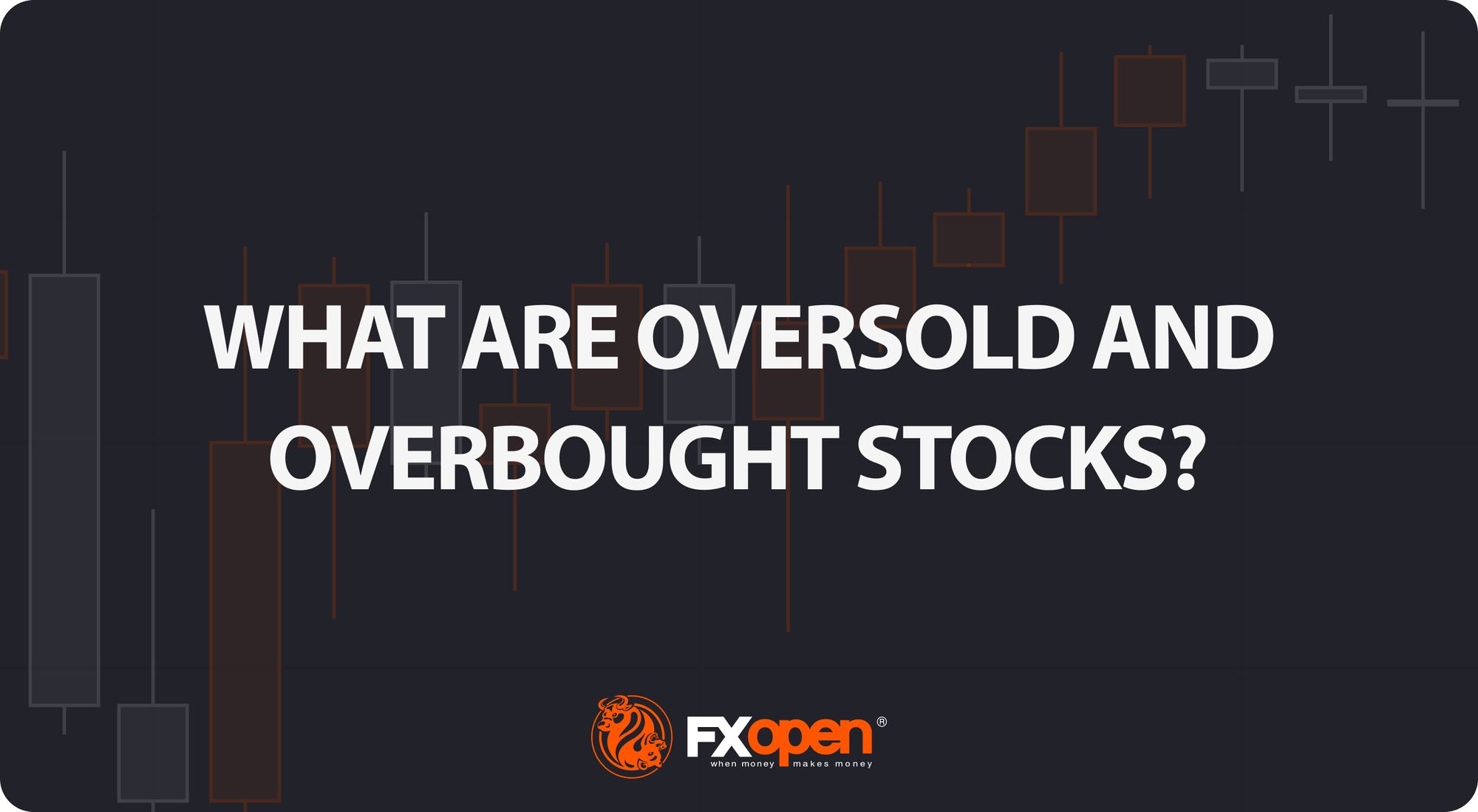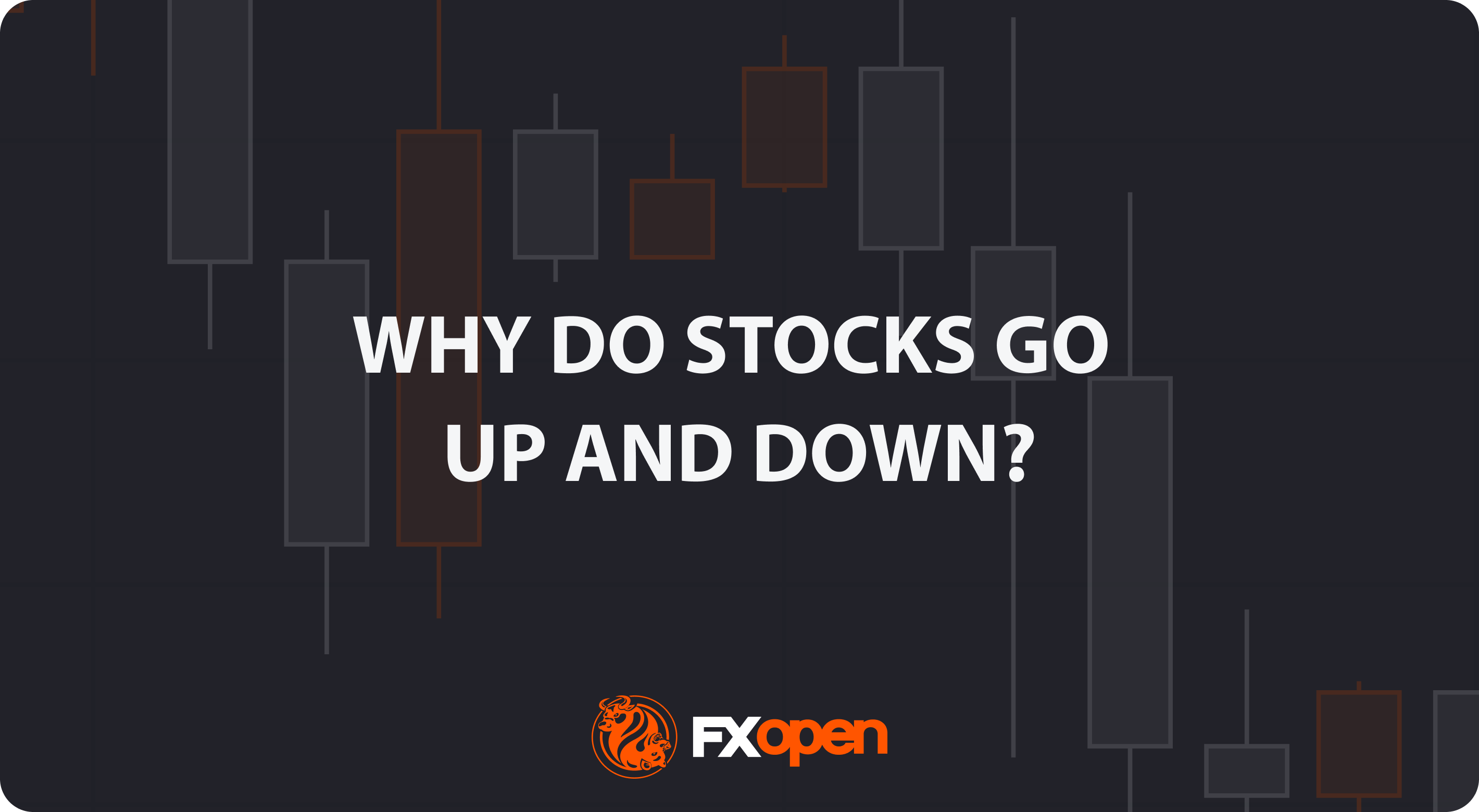FXOpen

Identifying overbought and oversold stocks is a key part of technical analysis for traders. These conditions occur when a market’s price moves to extremes—either too high or too low—compared to its recent performance. By recognising these signals, traders can spot potential turning points in the market. This article explores what overbought and oversold stocks are, how to find them using technical indicators, and the risks involved in trading them.
What Is an Oversold Stock?
Oversold stocks are those that have experienced a significant price decline, often beyond what might seem reasonable based on their underlying value. This often happens when market sentiment is overly negative, even if the company’s fundamentals remain solid.
Several factors can lead to a stock becoming oversold. For instance, bad news about a company, such as a missed earnings report or legal troubles, can cause investors to sell off shares quickly. Broader market events, like economic downturns or changes in industry regulations, can also drive prices down across the board. Sometimes, even strong stocks get caught up in these waves of negativity.
The concept of overselling isn’t just about price falling, though—it’s about the potential for a reversal. When stocks fall too fast, too far compared to their actual financial performance or growth potential, this is where traders look for opportunities, analysing whether the market is poised for a potential recovery.
What Is an Overbought Stock?
Overbought stocks are those that have risen sharply in price, often to a point where they may no longer reflect the stock’s true value. When a stock is considered overbought, it means there’s been a lot of buying activity, pushing the price higher than what its fundamentals might justify. This often happens when market sentiment is extremely positive, driving demand even when shares may already be trading at high levels.
Several factors can lead to an overbought market. Sometimes, positive news about a company—such as strong earnings, new product launches, or positive analyst reports—can spark a wave of buying. Market-wide optimism, particularly during bullish phases, can also lead to an overbought stock market. Speculative buying, where traders hope to capitalise on short-term price movements, can further inflate the price.
Being overbought doesn’t necessarily mean the stock is due for an immediate correction, but it does suggest that the price may have gone too high, too quickly. The most overbought stocks are often viewed as being in a vulnerable position for a potential pullback, especially if there isn’t enough underlying support from the company’s financial health or growth prospects. Traders consider this an opportunity to sell stocks at potentially good prices.
How Traders Find Oversold and Overbought Stocks with Indicators
Traders use technical indicators to determine whether a stock might be undervalued (oversold) or overvalued (overbought) based on its price action. These indicators allow traders to assess whether a price movement has gone too far in one direction.
Technical indicators are tools that use historical price and volume data to measure things like price momentum and trend strength. When it comes to finding overbought or oversold stocks, momentum oscillators play a key role.
These oscillators measure the speed and magnitude at which an asset’s price is changing. If a market has been rising or falling too quickly, it could be a sign that it’s either overbought or oversold. Also, if a stock has moved too far away from its typical price range, it signals a possible reversal. Traders rely on indicators to determine when the price may be at an extreme, helping them find entry or exit points based on market conditions.
Now, let’s break down some of the most popular indicators used for this purpose. To see how they work for yourself, consider following along in FXOpen’s free TickTrader trading platform to access a world of stock CFDs.
Relative Strength Index (RSI)
The Relative Strength Index (RSI) is one of the most widely used overbought and oversold indicators. The RSI is a momentum indicator that gauges how fast and how much a stock's price is moving. It gives traders a visual signal of when a stock may have been pushed too far in either direction.
RSI compares the magnitude of recent gains to recent losses to assess whether a stock is overbought or oversold. The indicator ranges from 0 to 100 and is typically used to evaluate whether a stock is moving too fast in either direction. If the RSI falls below 30, the stock is considered oversold, suggesting it could be undervalued and due for a bounce. If the RSI rises above 70, the stock is seen as in an overbought zone, potentially signalling a price correction on the horizon.
While RSI can be helpful, it’s essential to look at it in the context of the broader market. For example, in a strong bull market, a stock might remain overbought for an extended period. Similarly, during a downturn, stocks can stay oversold longer than expected.
Stochastic Oscillator
The Stochastic Oscillator is another momentum indicator. It compares a stock's closing price to its price range over a certain period. The idea behind this indicator is that in an uptrend, prices will close near their highs, and in a downtrend, prices will close near their lows.
The Stochastic Oscillator helps traders identify when a stock’s price has potentially moved too far in either direction relative to its recent range. It’s similar in principle to the RSI, except the Stochastic is considered more useful for detecting shorter-term reversals.
It’s especially useful for identifying overbought and oversold conditions because it moves within a range — between 0 and 100 — similar to the RSI. The Stochastic Oscillator is made up of two lines: %K, which is the primary line, and %D, a moving average of %K. When these lines are above 80, the stock is considered overbought. When they are below 20, it’s considered oversold.
Given its sensitivity, it’s common to see the Stochastic signals a market is overextended for a longer period when there’s a strong trend. This makes it more prone to false signals than the RSI or MACD indicator and typically more useful for trading pullbacks in a broader trend.
MACD (Moving Average Convergence Divergence)
The Moving Average Convergence Divergence (MACD) is another popular overbought and oversold indicator. Unlike the RSI, which focuses primarily on oversold vs overbought levels, MACD is more about trend strength and its direction. It shows the relationship between two moving averages of an asset’s price and can help identify potential shifts in momentum.
The MACD consists of two lines: the MACD line (which is the difference between the 12-day and 26-day exponential moving averages) and the signal line (the 9-day moving average of the MACD line). When the MACD line crosses above the signal line, it indicates a potential bullish reversal. When it crosses below, it signals a bearish reversal.
Since the lines are based on the difference between two EMAs, it’s also possible to gauge an overbought/oversold stock by examining the distance of the lines between their current values and the 0 midpoint. If the lines are far away from 0 and their historical averages, it could indicate a stock is overbought or oversold.
However, generally speaking, MACD is less about pinpointing specific overbought/oversold levels and more about identifying when momentum is shifting. A rapid crossover of the lines, especially after a strong move, can signal that a reversal might be near.
Considerations When Using Momentum Indicators
While momentum indicators like the RSI and MACD can be useful for spotting overextended stocks, there are a couple of key points to keep in mind when using these oversold and overbought indicators:
Divergences
A divergence occurs when the price moves in the opposite direction to the indicator. For example, if a stock is making higher highs but the indicator is making lower highs, this can signal weakening momentum and a possible reversal. Divergences offer another layer of insight, so it's worth paying attention to them alongside other factors.
Timeframes
Different timeframes can produce different results. An indicator that shows a stock is oversold on a daily chart might not show the same on a weekly chart. It's important to choose the right timeframe for your trading strategy, whether short-term or long-term. Generally, many traders take a top-down approach, allowing higher timeframe signals to better inform your analysis on lower timeframes.
Risks of Trading Oversold and Overbought Stocks
Trading oversold and overbought stocks can be appealing, as these conditions often suggest a potential reversal in price. However, there are some risks to consider when relying on these signals. A few important points to bear in mind include:
- False Signals: Just because a market is oversold or overbought doesn’t guarantee a reversal. Prices can continue to decline or rise despite what momentum indicators suggest. Traders need to be cautious about assuming that every extreme condition will result in a price correction.
- Extended Trends: In strong bullish or bearish trends, a stock can remain in overbought or oversold territory for longer than expected. This can lead to premature trades, where investors get in too early or expect a reversal that doesn’t come for a while.
- Market Sentiment: Sometimes, external factors like news events or broader economic conditions can overpower technical indicators. If there’s overwhelming optimism or pessimism in the market, a stock may continue in its overbought or oversold condition for longer than anticipated.
- Lack of Confirmation: Relying on a single indicator can be risky. It’s common to use multiple indicators or combine technical and fundamental analysis for a more balanced view. There may be no other supporting signals when a stock is oversold, meaning the trade carries higher risk.
The Bottom Line
Understanding overbought and oversold stocks, along with the indicators used to identify them, can help traders spot potential market opportunities. While these conditions may signal a reversal, it’s important to recognise there is no one best overbought and oversold indicator and use multiple tools for confirmation. Ready to apply these insights? Open an FXOpen account today to access more than 700 markets, including a huge range of stock CFDs, and four advanced trading platforms.
FAQ
What Is Overbought and Oversold?
Overbought and oversold are terms used to describe extreme price movements in markets. A stock is considered overbought when its price has risen rapidly and above its underlying value, which potentially makes it overvalued. It’s oversold when the price has fallen sharply and below its underlying value, which makes it undervalued. These conditions can signal that a price reversal may be coming, though they don’t guarantee it.
What Does It Mean for a Stock to Be Overbought?
The overbought stock meaning refers to a stock that has increased quickly and is potentially trading higher than its actual value. This often occurs due to strong demand or market optimism. Overbought conditions might signal that the price is at risk of a pullback.
What Does It Mean When a Stock Is Oversold?
The oversold stock meaning refers to a stock that has dropped significantly and may be below its true value. This often happens when there’s been excessive selling, and it could suggest that its price is due for a rebound.
How Can You Find Oversold Stocks?
Traders often use technical indicators like the Relative Strength Index (RSI) to find the most oversold stocks. An RSI reading below 30 typically suggests that a stock is oversold and may present a buying opportunity. Other indicators, like the Stochastic Oscillator, are also commonly used to identify oversold conditions.
This article represents the opinion of the Companies operating under the FXOpen brand only. It is not to be construed as an offer, solicitation, or recommendation with respect to products and services provided by the Companies operating under the FXOpen brand, nor is it to be considered financial advice.
Stay ahead of the market!
Subscribe now to our mailing list and receive the latest market news and insights delivered directly to your inbox.








